Clean Energy
Charted: Progress on 2030 Renewable Energy Targets by Country
The following content is sponsored by the National Public Utilities Council
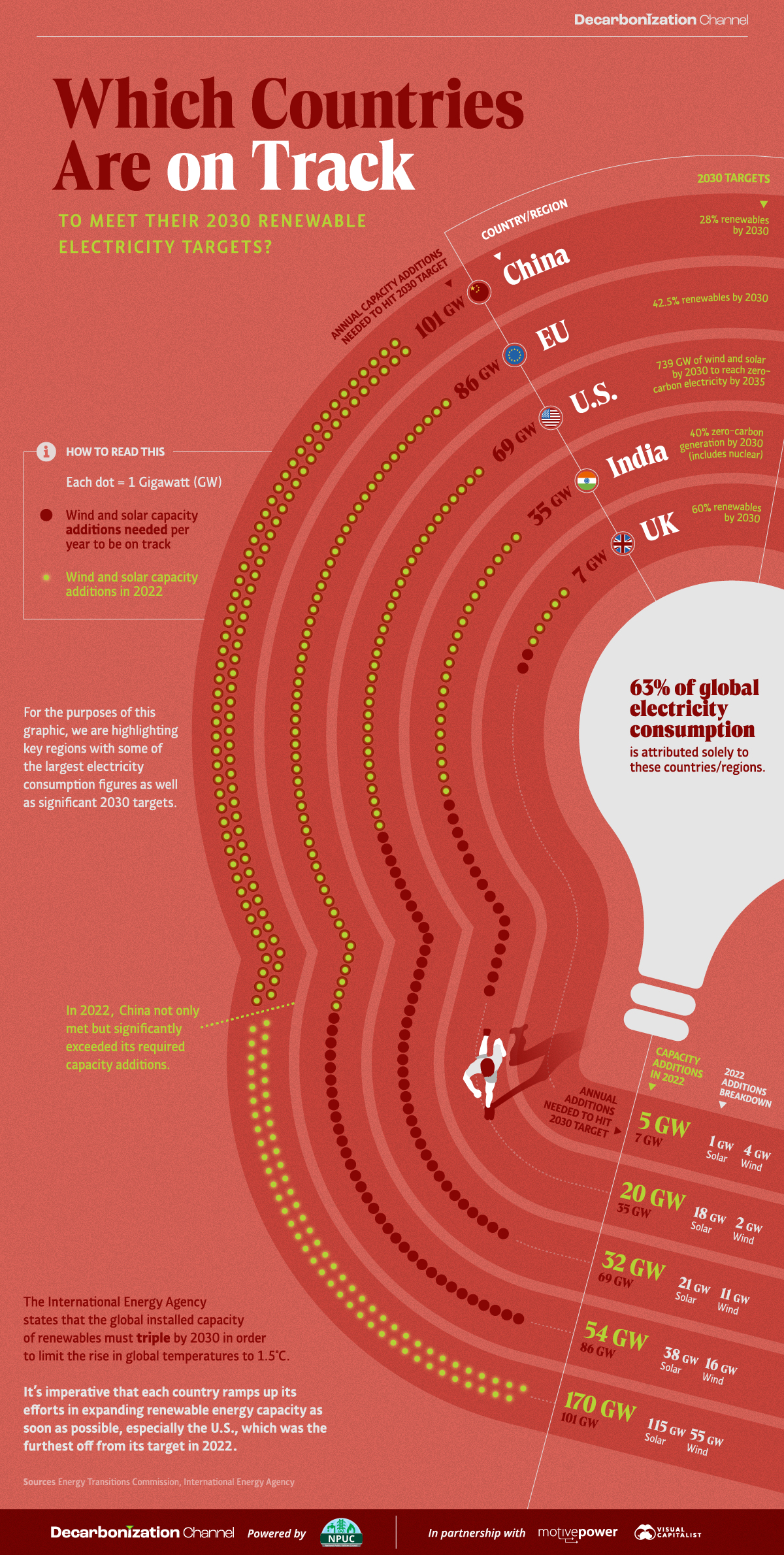
Progress on 2030 Renewable Energy Targets by Country
The International Energy Agency states that the global installed capacity of renewable energy must triple by 2030 to limit global warming to 1.5°C above pre-industrial levels.
This makes the next six years critical in the climate fight, with the upcoming United Nations COP28 event in Dubai representing a great time to assess the progress of countries toward achieving their 2030 targets.
Checking in on Progress
As set out by their Nationally Determined Contributions in the Paris Agreement, many countries, including major electricity consumers such as the U.S., European Union, China, India, and the UK, have set ambitious targets for increasing their solar and wind power generation capacities by 2030.
The data, however, suggests that many are struggling to keep pace with the required annual capacity additions that will allow them to hit these targets.
Currently, China stands out as the only nation on track to meet its 2030 target. In 2022, it not only met but significantly exceeded its required capacity additions to remain on track, adding 168% of the required 101 GW.
Let’s now take a closer look at how each of these countries are faring, comparing how much wind and solar capacity they needed to add with how much they actually did in 2022.
| Country / Region | 2030 Target | Annual Average Wind and Solar Capacity Additions Needed to Hit 2030 Target | Actual Capacity Additions in 2022 | ||||
|---|---|---|---|---|---|---|---|
| Wind | Solar | Total | Wind | Solar | Total | ||
| India | 40% zero-carbon generation by 2030 (includes nuclear) | 16 GW | 19 GW | 35 GW | 2 GW | 18 GW | 20 GW |
| China | 28% renewables by 2030 | 57 GW | 44 GW | 101 GW | 55 GW | 115 GW | 170 GW |
| United States | 739 GW of wind and solar by 2030 to reach zero-carbon electricity by 2035 | 34 GW | 35 GW | 69 GW | 11 GW | 21 GW | 32 GW |
| United Kingdom | 60% renewables by 2030 | 4 GW | 3 GW | 7 GW | 4 GW | 1 GW | 5 GW |
| European Union | REPowerEU: 42.5% renewables by 2030 | 38 GW | 48 GW | 86 GW | 16 GW | 38 GW | 54 GW |
Overall, the U.S. and India were the furthest off from their targets in 2022, adding only 46% and 57% of what was needed, respectively. European countries, on the other hand, made progress but still need substantial annual additions to meet their targets by 2030.
Playing Catch-Up: The Path to 2030
Collectively, the U.S., European Union, China, India, and the UK account for more than 60% of global electricity consumption, underscoring their profound responsibility in decarbonizing their electricity sectors.
Investments in research and development, policy support, and infrastructure development are all crucial pieces of the puzzle when it comes to achieving 2030 targets.
With swift and bold action, these nations have an opportunity to transform the global energy landscape and move the needle toward achieving net-zero on a global scale.
Learn more about how electric utilities and the power sector can lead on the path toward decarbonization here.
Clean Energy
Visualized: The Four Benefits of Small Modular Reactors
What advantages do small modular reactors offer compared to their traditional counterparts?
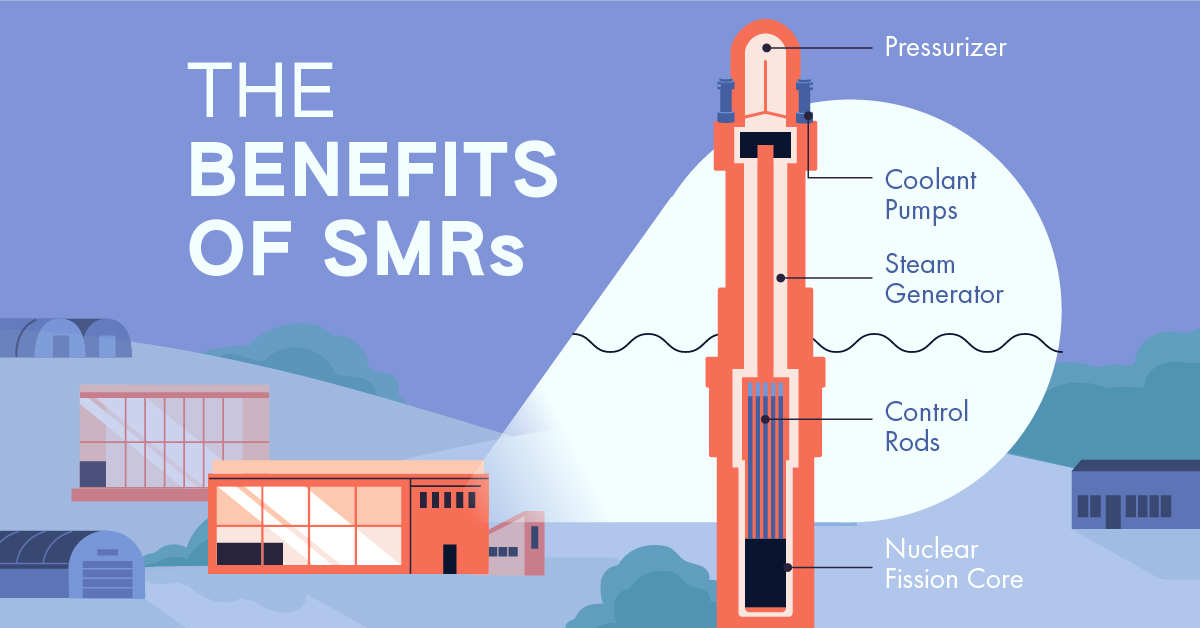
Visualized: The Four Benefits of Small Modular Reactors
Nuclear power has a crucial role to play on the path to net zero. Traditional nuclear plants, however, can be costly, resource-intensive, and take up to 12 years to come online.
Small modular reactors (SMR) offer a possible solution.
Created in partnership with the National Public Utilities Council, this infographic explores some of the benefits SMRs can offer their traditional counterparts. Let’s dive in.
The Four Key Benefits of SMRs, Explained
An SMR is a compact nuclear reactor that is typically less than 300 megawatts electric (MWe) in capacity and manufactured in modular units.
Here are some of the benefits they offer.
#1: Lower Costs
SMRs require a lower upfront capital investment due to their compact size.
SMRs can also match the per-unit electricity costs of traditional reactors due to various economic efficiencies related to their modular design, including design simplification, factory fabrication, and potential for regulatory harmonization.
#2: Quicker Deployment
Traditional nuclear plants can take up to 12 years to become operational. This is primarily due to their site-specific designs and substantial on-site labor involved in construction.
SMRs, on the other hand, are largely manufactured in factories and are location-independent, which minimizes on-site labor and expedites deployment timelines to as little as three years. This means they can be deployed relatively quickly to provide emissions-free electricity to the grid, supporting growing electricity needs.
#3: Siting Flexibility and Land Efficiency
SMRs have greater siting flexibility compared to traditional reactors due to their smaller size and modular design. In addition, they can utilize land more effectively than traditional reactors, yielding a higher output of electrical energy per unit of land area.
| Rolls-Royce SMR, UK (Proposed) | Median-Sized U.S. Nuclear Plant | |
|---|---|---|
| Capacity | 470 MW | 1,000 MW |
| Area Requirement | 10 Acres* | 832 Acres |
| Land/Space Efficiency | 47 MW/Acre | 1.2 MW/Acre |
*Estimated area requirement
Given their flexibility, SMRs are also suitable for installation on decommissioned coal power plant sites, which can support the transition to clean electricity while utilizing existing transmission infrastructure.
#4: Safety
SMRs have simpler designs, use passive cooling systems, and require lower power and operating pressure, making them inherently safer to operate than traditional reactors.
They also have different refueling needs compared to traditional plants, needing refueling every 3–7 years instead of the 1–2 years typical for large plants. This minimizes the transportation and handling of nuclear fuel, mitigating the risk of accidents.
The Road Ahead
As of early 2024, only five SMRs are operating worldwide. But with several other projects under construction and nearly 20 more in advanced stages of development, SMRs hold promise for expanding global emission-free electricity capacity.
With that said, certain obstacles remain for the wide-scale adoption of SMRs in the United States, which was particularly apparent in the 2023 cancellation of the NuScale SMR project.
To fully realize the benefits of SMRs and advance decarbonization efforts, a focus on financial viability, market readiness, and broader utility and public support may be essential.
Learn how the National Public Utilities Council is working toward the future of sustainable electricity.
Clean Energy
The $3 Trillion Clean Energy Investment Gap, Visualized
In this graphic, we explore the $3 trillion clean energy investment gap visualized by sector, according to BloombergNEF data.

The $3 Trillion Clean Energy Investment Gap, Visualized
Global investment in the clean energy transition grew by 17% in 2023, showing resilience despite geopolitical tensions, high interest rates, and inflation.
But was it enough to keep the world on track to hit net zero by 2050?
To answer this question, we compare 2023 clean energy investment by sector with what’s annually needed to reach net zero by 2050, in partnership with the National Public Utilities Council.
The Investment Gap, By Sector
According to BloombergNEF data, annual global investment in the energy transition is at an all-time high. Despite this, only the electrified heat and clean industry sectors are meeting the thresholds necessary to hit net zero by 2050.
| 2023 Investment | Required Annual Investment for Net Zero*, 2024–2030 | Investment Gap | |
|---|---|---|---|
| Electrified transport | $632B | $1,805B | $1,173B |
| Renewable energy | $623B | $1,317B | $694B |
| Electricity grids | $310B | $700B | $390B |
| Electrified heat | $63B | $50B | -$13B |
| Clean industry | $49B | $21B | -$28B |
| Energy storage | $36B | $93B | $57B |
| Nuclear energy | $33B | $284B | $251B |
| Carbon capture and storage (CCS) | $11B | $510B | $499B |
| Hydrogen | $10B | $62B | $52B |
| TOTAL | $1,767B | $4,842B | $3,075B |
*BloombergNEF’s Net-Zero 2050 Scenario
To stay on track for net zero by 2050, the yearly investments in electrified transport, renewable energy, power grids, and energy storage must more than double their current rates for the rest of the decade.
Hydrogen, nuclear, and carbon capture and storage (CCS) have an even steeper hill to climb and must grow 6, 9, and 46 fold, respectively.
The Path Forward
It’s important to note that despite the current annual investment gap of $3T, the clean energy industry continues to exhibit positive trends.
Investment in electrified transport, for instance, surpassed that in renewable energy for the first time in 2023, marking a win for the sector.
Emerging sectors also experienced robust expansion despite being furthest off-target. Investments in hydrogen tripled to $10B, CCS nearly doubled to $11B, and energy storage witnessed a 76% increase to reach $36B in 2023.
These encouraging developments underscore the industry’s potential to drive transformative change and pave the way for a more sustainable and resilient energy landscape in the years ahead.
Learn how the National Public Utilities Council is working toward the future of sustainable electricity.
-
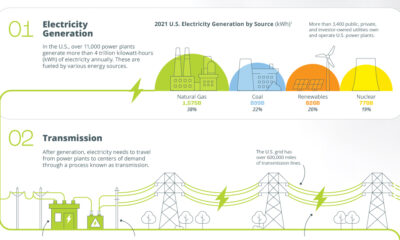
 Electrification1 year ago
Electrification1 year agoVisualized: How the Power Grid Works
-
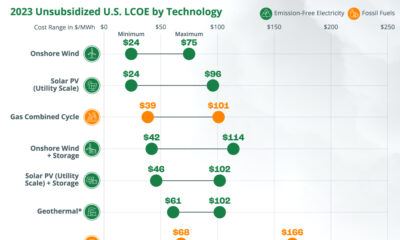
 Energy Shift9 months ago
Energy Shift9 months agoRanked: The Cheapest Sources of Electricity in the U.S.
-
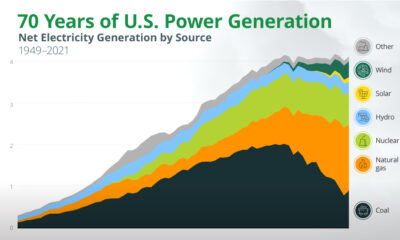
 Energy Shift1 year ago
Energy Shift1 year agoAnimated: 70 Years of U.S. Electricity Generation by Source
-

 Clean Energy1 year ago
Clean Energy1 year agoBreaking Down Clean Energy Funding in the Inflation Reduction Act
-
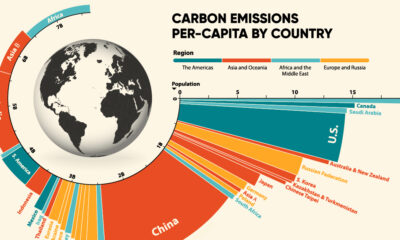
 Emissions1 year ago
Emissions1 year agoVisualizing Global Per Capita CO2 Emissions
-
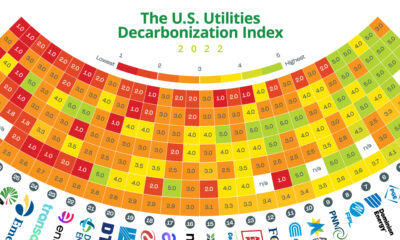
 Decarbonization1 year ago
Decarbonization1 year agoThe U.S. Utilities Decarbonization Index
-
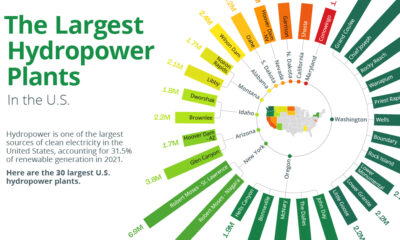
 Clean Energy1 year ago
Clean Energy1 year agoThe 30 Largest U.S. Hydropower Plants
-

 Clean Energy7 months ago
Clean Energy7 months agoBreaking Down the $110 Trillion Cost of the Clean Energy Transition

